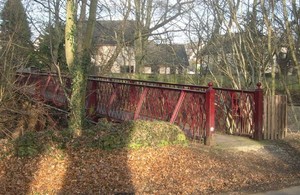Engineers answer SOS call to rescue symbolic railway structure
An iconic railway bridge which dates back to the early 20th century is set to gain a new lease of life.

Historical Railways Estate (HRE) has answered a call for help from Scottish Borders Council to come up with a plan to repair Boleside Road footbridge and make it safe for the public to use again.
The local authority closed the former railway structure, which carries a footpath across the former Selkirk Branch near Galashiels in the Scottish Borders, at the turn of the year after raising concerns over its condition and instigated an ownership search.
HRE, operating on behalf of Highways England, is now working closely with the council to secure the future of the bridge, which is one of the few surviving structural elements from the railway network in Galashiels.
Highways England civil engineer Colin McNicol said:
This cherished footbridge has a rich history and we are determined to extend its life for many years to come.
Until its recent closure the structure gave the public a chance to enjoy popular riverside walks, which took on new significance for people exercising during the Covid-19 pandemic.
HRE maintains more than 3,000 structures across the UK for the Department for Transport. Boleside Road footbridge wasn’t one of them, and was brought to HRE’s attention in January when the local authority asked for assistance.
It’s now been added to the HRE and engineers have already carried out an examination to determine its state, paving the way for a plan to be developed. The next step will see a designer and contractor appointed to put together a repair scheme that will allow for public use once again.
The footbridge is held in high regard by those who have frequented it over the years, not least because of its fascinating backstory. The Edinburgh and Hawick Railway was opened in 1849 by the North British Railway and formed the first part of the line from Edinburgh to Carlisle. The railway through Galashiels was initially known as the Border union, but in 1862 it was officially named the Waverley line, to emphasise the connection with the celebrated novelist Sir Walter Scott, as nearby Abbotsford increased in popularity as a literary shrine.
In 1856 the branch line opened to Selkirk although this footbridge doesn’t show up on the map until 1930. It’s possible that a later footbridge was required at this location to improve access from the developing areas of housing to the east end of Abbotsford Road with the river for recreational purposes.
Due to the development of transport by road the Selkirk line was closed to passenger transport in 1951 and to goods in 1964, at which point the footbridge became redundant. However, up until its recent closure, the public continued to make use of the structure as it spans the remaining embankments and links a late 20th century housing estate to the north west directly to those much-needed walks by the water.
General enquiries
Members of the public should contact the Highways England customer contact centre on 0300 123 5000.
Media enquiries
Journalists should contact the Highways England press office on 0844 693 1448 and use the menu to speak to the most appropriate press officer.